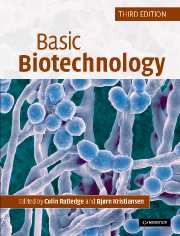Book contents
- Frontmatter
- Contents
- List of contributors
- Preface to the second edition
- Preface to the third edition
- Part I Fundamentals and principles
- Part II Practical applications
- Chapter 12 High-throughput screening and process optimisation
- Chapter 13 The business of biotechnology
- Chapter 14 Amino acids
- Chapter 15 Organic acids
- Chapter 16 Microbial polysaccharides and single cell oils
- Chapter 17 Environmental applications
- Chapter 18 Production of antibiotics by fermentation
- Chapter 19 Strategies of cultivation
- Chapter 20 Enzyme biotechnology
- Chapter 21 Recombinant proteins of high value
- Chapter 22 Insect and mammalian cell culture
- Chapter 23 Plant cell biotechnology
- Chapter 24 Biotransformations
- Chapter 25 Immunochemical applications
- Index
Chapter 18 - Production of antibiotics by fermentation
Published online by Cambridge University Press: 05 June 2012
- Frontmatter
- Contents
- List of contributors
- Preface to the second edition
- Preface to the third edition
- Part I Fundamentals and principles
- Part II Practical applications
- Chapter 12 High-throughput screening and process optimisation
- Chapter 13 The business of biotechnology
- Chapter 14 Amino acids
- Chapter 15 Organic acids
- Chapter 16 Microbial polysaccharides and single cell oils
- Chapter 17 Environmental applications
- Chapter 18 Production of antibiotics by fermentation
- Chapter 19 Strategies of cultivation
- Chapter 20 Enzyme biotechnology
- Chapter 21 Recombinant proteins of high value
- Chapter 22 Insect and mammalian cell culture
- Chapter 23 Plant cell biotechnology
- Chapter 24 Biotransformations
- Chapter 25 Immunochemical applications
- Index
Summary
Introduction
Production of antibiotics by fermentation, either for use directly in human therapy or to act as feedstock for the synthesis of chemically modified derivatives of the core antibiotic structure, still make up the majority contribution of antibiotic agents in the treatment of human disease. Only two classes of chemically synthetic agents have significant market share as antibiotic agents: the sulphonamides and the fluoroquinolones. A novel chemical class, the oxazolidinones, recently entered the marketplace but still does not have significant market penetration, and is carefully managed as a reserve antibiotic. Also, in the current reimbursement environment, it is clear that it will be extremely difficult for any new antibiotic to compete economically with generic β-lactams, macrolides and tetracyclines unless they have a distinct clinical advantage and improved cost of care.
The continued development of antibiotic-resistant organisms has started to reveal weaknesses in the armoury of drugs available to treat serious hospital and community acquired infections. Thus the focus in drug discovery has shifted away from the identification of broad spectrum antibiotics to new entities that target the resistant organisms. A focus on this market niche, however, reduces the potential market for these new narrow-spectrum agents and has an impact on business decisions whether or not to proceed with discovery efforts. In addition, the emphasis on cost savings by the health-care industry continues to drive the expansion of use of generic broad spectrum antibiotics where they are effective.
- Type
- Chapter
- Information
- Basic Biotechnology , pp. 433 - 456Publisher: Cambridge University PressPrint publication year: 2006
- 3
- Cited by



